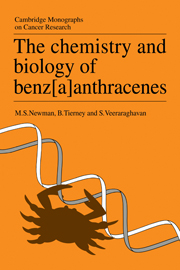9 - DNA, RNA and protein interactions
Published online by Cambridge University Press: 07 September 2010
Summary
Introduction
The transformation of a normal cell into a malignant cell, after exposure to a chemical carcinogen, is the result of a complex series of biochemical events. It is generally believed that the initial step involves the reaction of an electrophile (formed from the carcinogen either directly or by metabolism) with cellular macromolecules such as DNA, RNA and protein. Which of these cellular macromolecules represents the critical target for the chemical carcinogen in the initiation of the carcinogenic process has been the subject of much theoretical discussion. The somatic mutation theory proposes that some permanent inheritable change in the nucleotide sequence occurs as the result of an alteration, deletion or rearrangement of the primary structure of DNA. Alternatively, epigenetic changes in cellular transcription and translation may bring about malignant cell transformation; such epigenetic changes also occur in normal development and differentiation (see Rubin, 1980; Marquardt, 1979a; and Barrett and Ts'o, 1978, for a fuller discussion of these hypotheses). The weight of evidence currently favours the somatic mutation theory, and underlies the widespread acceptance of the use of short-term mutation assays, such as the Ames Test, to indicate compounds with potential carcinogenic activity (many chemical carcinogens are mutagens). The DNA adducts formed in vivo and in vitro after attack by PAHs have been, in general, well characterized in terms of their chemical structure: it is often known which bases are involved, whereabouts on the base the PAH has bound and what type of functional group on the PAH is responsible for such binding.
- Type
- Chapter
- Information
- The Chemistry and Biology of Benz[a]anthracenes , pp. 113 - 143Publisher: Cambridge University PressPrint publication year: 1988



